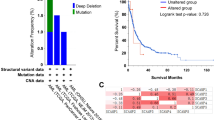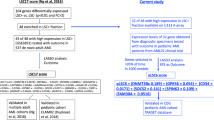Abstract
Acute myeloid leukemia (AML) is a malignant disease of myeloid hematopoietic stem or progenitor cells characterized by abnormal proliferation of primary and immature myeloid cells in bone marrow and peripheral blood. Gene mutation and expression profiles can be used as prognosis predictors for different prognostic subgroups. Secretory carrier-associated membrane proteins (SCAMPs) are a multigenic family with five members and act as cell surface vectors in the post-Golgi recycling pathways in mammals. Nevertheless, the prognostic and clinical influence of SCAMP family has hardly ever been illustrated in AML. In our study, expression patterns of SCAMP family (SCAMP1–5) were analyzed in 155 AML patients which were extracted from the Cancer Genome Atlas database. In chemotherapy, only subgroup, higher SCAMP1 level was significantly associated with longer EFS and OS (all P = 0.002), and SCAMP1 was confirmed to be an independent favorable factor in un-transplanted patients by Multivariate analysis (all P < 0.05). Nevertheless, in the allogeneic hematopoietic stem cell transplantation (allo-HSCT) treatment subgroup, none of the SCAMP genes had any effect on the clinical survival. Our study found that high expression level of SCAMP1 is a favorable prognostic factor in AML, but allo-HSCT may neutralize its prognostic effect.
This is a preview of subscription content, access via your institution
Access options
Subscribe to this journal
Receive 6 print issues and online access
$259.00 per year
only $43.17 per issue
Buy this article
- Purchase on Springer Link
- Instant access to full article PDF
Prices may be subject to local taxes which are calculated during checkout

Similar content being viewed by others
References
Papaemmanuil E, Gerstung M, Bullinger L, Gaidzik VI, Paschka P, Roberts ND, et al. Genomic classification and prognosis in acute myeloid leukemia. N Engl J Med. 2016;374:2209–21.
O’Donnell MR, Tallman MS, Abboud CN, Altman JK, Appelbaum FR, Bhatt VR et al. NCCN Clinical Practice Guidelines in Oncology Acute Myeloid Leukemia (version 3.2018). NCCN Guidel. 2018. https://doi.org/10.1056/NEJMra1406184.
Sakaguchi M, Yamaguchi H, Najima Y, Usuki K, Ueki T, Oh I, et al. Prognostic impact of low allelic ratio FLT3- ITD and NPM1 mutation in acute myeloid leukemia. Blood Adv. 2018;2:2744–54.
Pratcorona M, Brunet S, Nomdedéu J, Ribera JM, Tormo M, Duarte R, et al. Favorable outcome of patients with acute myeloid leukemia harboring a low-allelic burden FLT3-ITD mutation and concomitant NPM1 mutation: relevance to post-remission therapy. Blood 2013;121:2734–8.
Wouters BJ, Löwenberg B, Erpelinck-Verschueren CAJ, van Putten WL, Valk PJM, Delwel R. Double CEBPA mutations, but not single CEBPA mutations, define a subgroup of acute myeloid leukemia with a distinctive gene expression profile that is uniquely associated with a favorable outcome. Blood 2009;113:3088–92.
Schnittger S, Dicker F, Kern W, Wendland N, Sundermann J, Alpermann T, et al. RUNX1 mutations are frequent in de novo AML with noncomplex karyotype and confer and unfavorable prognosis. Blood 2011;117:2348–57.
Pratcorona M, Abbas S, Sanders MA, Koenders JE, Kavelaars FG, Erpelinck-Verschueren CAJ, et al. Acquired mutations in ASXL1 in acute myeloid leukemia: prevalence and prognostic value. Haematologica 2012;97:388–92.
Zong X, Yao H, Wen L, Ma L, Wang Q, Yang Z, et al. ASXL1 mutations are frequent in de novo AML with trisomy 8 and confer an unfavorable prognosis. Leuk Lymphoma 2017;58:204–6.
Fathi AT, Chen Y. Bin. Treatment of FLT3-ITD acute myeloid leukemia. Am J Blood Res. 2011;1:175–89.
Bowen D, Groves M, Burnett A, Patel Y, Allen C, Green C, et al. TP53 gene mutation is frequent in patients with acute myeloid leukemia and complex karyotype, and is associated with very poor prognosis. Leukemia 2009;23:203–6.
Hou HA, Kuo YY, Liu CY, Chou WC, Lee MC, Chen CY, et al. DNMT3A mutations in acute myeloid leukemia-stability during disease evolution and the clinical implication. Blood 2011;118:559–69.
Döhner H, Weisdorf DJ, Bloomfield CD. Acute myeloid leukemia. N Engl J Med. 2015;373:1136–52.
Cui L, Cheng Z, Liu Y, Dai Y, Pang Y, Jiao Y et al. Overexpression of PDK2 and PDK3 reflects poor prognosis in acute myeloid leukemia. Cancer Gene Ther. 2018. https://doi.org/10.1038/s41417-018-0071-9.
Cheng Z, Dai Y, Pang Y, Jiao Y, Zhao H, Zhang Z, et al. Enhanced expressions of FHL2 and iASPP predict poor prognosis in acute myeloid leukemia. Cancer Gene Ther. 2019;26:17–25.
Zhang L, Li R, Hu K, Dai Y, Pang Y, Jiao Y et al. Prognostic role of DOK family adapters in acute myeloid leukemia. Cancer Gene Ther. 2018. https://doi.org/10.1038/s41417-018-0052-z.
Han C, Chen T, Yang M, Li N, Liu H, Cao X. Human SCAMP5, a novel secretory carrier membrane protein, facilitates calcium-triggered cytokine secretion by interaction with SNARE machinery. J Immunol 2009;182:2986–96.
Brand SH, Laurie SM, Mixon MB, Castle JD. Secretory carrier membrane proteins 31-35 define a common protein composition among secretory carrier membranes. J Biol Chem. 1991;266:18949–57.
Brand SH, Castle JD. SCAMP 37, a new marker within the general cell surface recycling system. EMBO J 1993;12:3753–61.
Wu TT, Castle JD. Evidence for colocalization and interaction between 37 and 39 kDa isoforms of secretory carrier membrane proteins (SCAMPs). J Cell Sci. 1997;110:1533–41.
Singleton DR, Wu TT, Castle JD. Three mammalian SCAMPs (secretory carrier membrane proteins) are highly related products of distinct genes having similar subcellular distributions. J Cell Sci. 1997;110:2099–107.
Krebs CJ, Pfaff DW. Expression of the SCAMP-4 gene, a new member of the secretory carrier membrane protein family, is repressed by progesterone in brain regions associated with female sexual behavior. Mol Brain Res. 2001;88:144–54.
Choi YP, Shim HS, Gao MQ, Kang S, Cho NH. Molecular portraits of intratumoral heterogeneity in human ovarian cancer. Cancer Lett 2011;307:62–71.
Yang S, Lee KT, Lee JY, Lee JK, Lee KH, Rhee JC. Inhibition of SCAMP1 suppresses cell migration and invasion in human pancreatic and gallbladder cancer cells. Tumor Biol 2013;34:2731–9.
Vadakekolathu J, Al-Juboori SIK, Johnson C, Schneider A, Buczek ME, Di Biase A, et al. MTSS1 and SCAMP1 cooperate to prevent invasion in breast cancer. Cell Death Dis. 2018;9:344.
Asghari M, Abazari MF, Bokharaei H, Aleagha MN, Poortahmasebi V, Askari H, et al. Key genes and regulatory networks involved in the initiation, progression and invasion of colorectal cancer. Future Sci OA 2018;4:FSO278.
Gupta V, Tallman MS, He W, Logan BR, Copelan E, Gale RP, et al. Comparable survival after HLA-well-matched unrelated or matched sibling donor transplantation for acute myeloid leukemia in first remission with unfavorable cytogenetics at diagnosis. Blood 2010;116:1839–48.
Ley TJ, Miller C, Ding L, Raphael BJ, Mungall AJ, Robertson G, et al. Genomic and epigenomic landscapes of adult de novo acute myeloid leukemia. N Engl J Med. 2013;368:2059–74.
Biewenga P, Buist MR, Moerland PD, van Themaat EVL, van Kampen AHC, ten Kate FJW, et al. Gene expression in early stage cervical cancer. Gynecol Oncol 2008;108:520–6.
Bally C, Adès L, Renneville A, Sebert M, Eclache V, Preudhomme C, et al. Prognostic value of TP53 gene mutations in myelodysplastic syndromes and acute myeloid leukemia treated with azacitidine. Leuk Res 2014;38:751–5.
Haferlach C, Dicker F, Herholz H, Schnittger S, Kern W, Haferlach T. Mutations of the TP53 gene in acute myeloid leukemia are strongly associated with a complex aberrant karyotype. Leukemia 2008;22:1539–41.
Kadia TM, Jain P, Ravandi F, Garcia-Manero G, Andreef M, Takahashi K, et al. TP53 mutations in newly diagnosed acute myeloid leukemia: clinicomolecular characteristics, response to therapy, and outcomes. Cancer 2016;122:3484–91.
Juliusson G, Antunovic P, Derolf Å, Lehmann S, Mollgard L, Stockelberg D, et al. Age and acute myeloid leukemia: Real world data on decision to treat and outcomes from the Swedish Acute Leukemia Registry. Blood 2009;113:4179–87.
Bacher U, Haferlach C, Alpermann T, Kern W, Schnittger S, Haferlach T. Comparison of genetic and clinical aspects in patients with acute myeloid leukemia and myelodysplastic syndromes all with more than 50% of bone marrow erythropoietic cells. Haematologica 2011;96:1284–92.
Ley TJ, Ding L, Walter MJ, McLellan MD, Lamprecht T, Larson DE, et al. DNMT3A mutations in acute myeloid leukemia. N Engl J Med. 2010;363:2424–33.
Held G, Zenz T, Lubbert M, Paschka P, Krauter J, Kugler C-M, et al. TP53 alterations in acute myeloid leukemia with complex karyotype correlate with specific copy number alterations, monosomal karyotype, and dismal outcome. Blood 2012;119:2114–21.
Acknowledgements
This work was supported by grants from Xinjiang Joint Fund of National Natural Science Foundation of China (U1903117), the National Natural Science Foundation of China (81500118) to LF; the National Natural Science Foundation of China (61501519) to JS; and the National Natural Science Foundation of China (81600089) to JC.
Author information
Authors and Affiliations
Corresponding author
Ethics declarations
Conflict of interest
The authors declare that they have no conflict of interest.
Additional information
Publisher’s note Springer Nature remains neutral with regard to jurisdictional claims in published maps and institutional affiliations.
Rights and permissions
About this article
Cite this article
Qian, T., Cheng, Z., Quan, L. et al. Prognostic role of SCAMP family in acute myeloid leukemia. Pharmacogenomics J 20, 595–600 (2020). https://doi.org/10.1038/s41397-020-0149-2
Received:
Revised:
Accepted:
Published:
Issue Date:
DOI: https://doi.org/10.1038/s41397-020-0149-2
This article is cited by
-
SCAMP2/5 as diagnostic and prognostic markers for acute myeloid leukemia
Scientific Reports (2021)



